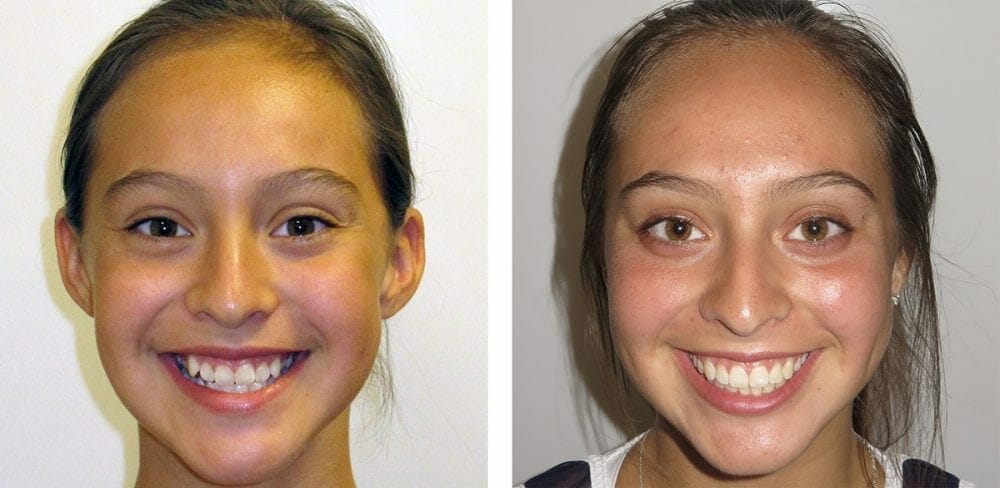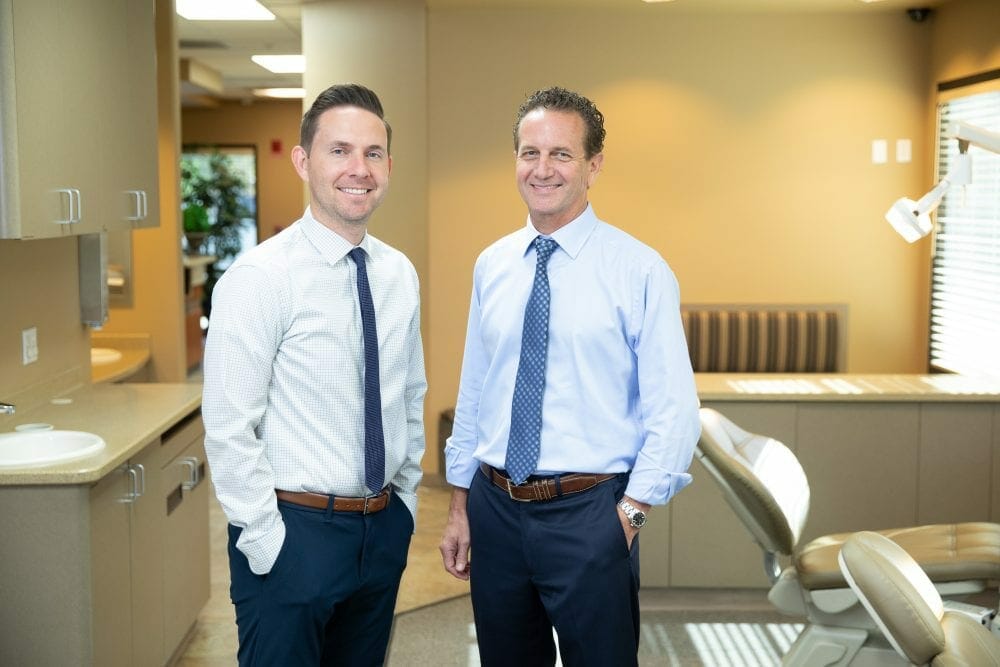Teen Braces in Temecula and Lake Elsinore
The teenage years have many rites of passage—puberty, a new school, and a driver’s license. In addition, for 80% of teenagers, this includes getting braces. If 5 teenagers were in a room, at least 4 of them will be wearing braces, have worn braces, or will soon be getting braces.
Teens are the perfect candidates for braces since it’s an ideal time in their lives for a dental alignment. Teenagers have more pliable jaw bones that are not as rigidly fused as an adult patient—making it easier to move teeth, shape the smile, and correct the bite.

Luckily for today’s teenagers, orthodontic options have greatly improved over 20-30 years ago. Technological advances have resulted in more comfortable and less noticeable braces. Patients also have the option of Invisalign®—an alternative to braces that use aligners (trays) to straighten teeth.
At Burke & Redford Orthodontists, we offer our patients exceptional alternatives—including self-ligating braces (such as Damon braces) and ceramic braces. Once the braces come off, retainers keep the new smile in place. We can also fit a customized sportsguard for teenage athletes.
Determining the Best Braces or Invisalign Option for Each Teen or Child
All types of braces, including Invisalign®, effectively straighten teeth, close gap teeth, and fix many types of orthodontic issues. The key is to determine which option is best for an individual patient. The decision comes down to a variety of factors, including the orthodontic concerns that need to be corrected, the patient’s personality and family finances.
During a teen’s initial visit and after the doctor’s examination, Dr. Burke or Dr. Redford will present a customized treatment plan and explain how that proposed solution works best for their unique situation.
The doctors will have an informative conversation with the teen and their parents to gather information about topics such as:
- How sensitive is the patient about their appearance?
- How mature or responsible is the patient?
- How likely is the patient to follow instructions or adhere to restrictions?
- Does the patient play any sports?
The answers help treat each patient to aid in choosing the correct type of individualized treatment plan.

Types of Braces for Teens
Invisalign® for Teens
Unlike braces that use wires and brackets, Invisalign for teens uses a series of transparent, customized aligners (trays) to reposition and straighten teeth. Patients switch to a new tray every 1-to-2 weeks. Office visits are scheduled approximately every 8 weeks to check on the patient’s progress.
Invisalign® is an increasingly popular option for teenagers due to the following benefits:
- Transparent Material. Most people don’t notice when someone is wearing the tray because it is clear.
- Removable for Eating. This means a patient can eat foods (such as popcorn at the movies) that must be avoided with traditional braces.
- Removable for Brushing and Flossing. Braces require special flossing techniques and need special attention to keep teeth clean. Because trays can be removed, patients can maintain their regular oral hygiene routine. This is perfect for patients who may not be inclined to follow brushing and flossing instructions.
Who is Right the Right Type of Patient for Invisalign®?
- This treatment option is best suited for patients who:
- Only need a mild alignment,
- Have teeth in good condition
- Lost most or all of their baby teeth
- Have permanent incisors and first molars that are fully erupted (not impacted) - The trays must be worn up 20-22 hours a day. If a patient is not mature enough for this responsibility, treatment will be ineffective.
- The aligners may infrequently become misplaced or lost. Parents know how easily their children can lose or misplace things. For this reason, those who are responsible make for the best Invisalign® teen patients.
- The trays may cause a slight lisp the first week or two for some patients during the initial adjustment period.

Self-Ligating Braces
- Self-ligating braces are similar to traditional braces, except they don’t require elastics to secure brackets to the archwire. Instead, this type of braces system uses special clips (or doors) to help the archwire move teeth into place. The clips allow for greater freedom of tooth movement, which reduces discomfort. Damon braces are one example of a self-ligating braces system.
Treatment length is often reduced with self-litigating braces because teeth move into place at a more even, gentle and continuous pace. Some patients have their treatment times shortened by up to 6 months.
Self-ligating braces are easier and quicker to adjust because the doors can easily be opened and closed. This means faster and more comfortable adjustment appointments. These types of braces are also easier to keep clean than traditional braces.
- Ceramic braces aren’t a different type of braces system. The name refers to the material used for the bracket. Instead of metal, ceramic braces are made of transparent or tooth-colored ceramic. The ceramic version of self-ligating braces is often referred to as self-ligating clear braces.
Ceramic braces are less noticeable and blend in better with a teenager’s teeth, thereby making them a great option for patients who don’t want shiny metal in their mouths. Staining with ceramic braces can be avoided by cleaning the teeth and braces properly each day.
- Lingual braces are placed on the back of teeth, which makes them less conspicuous. However, lingual braces have a few disadvantages. Treatment time is longer and more adjustments are required. Some patients may develop a lisp. Lingual braces are a little more difficult to clean and may cause irritation to the tongue.
Lingual braces might cost a bit more because they are custom-made. Each tooth has its own brackets and arch wires. However, for patients who want to straighten their teeth but don’t want their braces to show, lingual braces are a fantastic option.
Metal Braces
- Traditional metal braces have been used since the 1970s. Fortunately, they have come a long way since their introduction. Brackets have gotten smaller and less noticeable and materials are lighter and more comfortable.
While using traditional metal braces, metal brackets are applied to the front of each tooth and connected by a thin arch wire. This wire is used to manipulate teeth to move them into position. The archwire is attached to the brackets using tiny elastics known as ligatures (or o-rings). The braces will occasionally need to be adjusted to keep teeth moving into the correct positions. Traditional metal braces are typically the most economical.
Although traditional metal braces are used by many orthodontists, Burke & Redford Orthodontics rarely offer them to new patients without braces because the doctors believe self-ligating braces are the much better choice. However, Dr. Redford and Dr. Burke treat many patients who have moved into the area and are already wearing traditional metal braces.

Keeping the Smile After Braces with Retainers
After braces are removed, patients wear a retainer to keep teeth in place. This is to prevent conditions known as “settling” and “relapse.” After the time and expense of wearing braces, of course patients always want to keep their smile transformation beautiful.
Although each patient’s needs vary, retainers are typically worn for 24 hours a day for the first 3 months, except during meals. After this time, a patient will be told how often and for how long to they are required to wear their retainer.
Dr. Burke and Dr. Redford make customized retainers for each patient that fits the exact shape of their mouth and teeth. The retainers might be removable or permanent. Each case is different.
Athletic Teens Must Wear a Sportsguard
A sportsguard (also known as a sports mouthguard) is recommended for patients involved in almost any type of athletics—including basketball, soccer, football, baseball, LaCrosse, hockey, martial arts, and gymnastics.
A sportsguard prevents dental or facial injuries caused by accidental hits to the face. The mouthguard covers the teeth while also protecting the tongue, inside of cheeks and the jaw. If a teen is wearing braces, a mouthguard is even more crucial because it will prevent damage to the braces and trauma to the inside of the mouth.
Some people use mouthguards from sporting goods stores that can be molded by heating it and biting down. However, the best possible protection and comfort will come from a custom mouthguard made by an orthodontist. This is because a custom sportsguard will fit a teen’s teeth exactly, and it is made with the specific sport and level of play in mind.
Only two visits are required – one for impressions and one for fitting. The mouth guard can be made to match the school or team’s colors, too.
Frequently Asked Questions About Braces for Teens
What are the best types of braces for teens?
At Burke & Redford Orthodontists, teens can choose from several modern options depending on comfort, visibility, and lifestyle. Dr. Ryan Redford offers self-ligating metal braces, ceramic braces, and the popular Damon braces system, all designed for gentle, efficient tooth movement. Teens in Temecula, Murrieta, Menifee, Canyon Lake, Lake Elsinore, Wildomar, and Corona can also consider Invisalign Teen, which uses clear aligners instead of brackets and wires.
What makes Burke & Redford Orthodontists the top teenager orthodontist in Temecula?
Dr. Ryan Redford, a board-certified orthodontist, leads our team with decades of combined experience treating children and teenagers. Families across the Inland Empire appreciate our personalized approach, flexible scheduling, and free orthodontic consultations. Whether your teen needs Damon braces, ceramic braces, or Invisalign Teen, we tailor treatment to their bite, growth, and confidence goals.
Are braces still the best option for teenagers today?
Yes. Braces remain one of the most effective and affordable ways to align teeth and correct bites. At Burke & Redford Orthodontists, our self-ligating braces move teeth gently and efficiently, often with shorter treatment times and fewer office visits. Teens in Temecula, Lake Elsinore, and surrounding Inland Empire cities also love that ceramic braces blend with natural tooth color, while Damon braces deliver fast, comfortable results.
How long does teen braces treatment take at Burke & Redford Orthodontists?
Most teens complete orthodontic treatment in 18–24 months, though it varies by case complexity and appliance choice. Damon braces and self-ligating ceramic braces may slightly reduce time due to smoother wire adjustments. During your free consultation in Temecula our Lake Elsinore orthodontic office, Dr. Redford will evaluate your teen’s smile and outline a detailed plan, including expected treatment time and costs for families in Murrieta, Menifee, Canyon Lake, Wildomar, and Corona.
Can my active teenager play sports or instruments while wearing braces?
Absolutely. Many of our teen patients in Riverside County participate in sports and music. We offer custom sports mouthguards that fit comfortably over braces, protecting the teeth and soft tissues during games or practice. For band members, we adjust brackets and wires for better comfort. Whether your child chooses self-ligating braces, Damon braces, or Invisalign Teen, we make sure treatment fits their lifestyle.
What should parents know before starting teen braces treatment?
Before you get teen braces or aligners begin, Burke & Redford Orthodontists provides a full exam, digital imaging, and growth evaluation. Dr. Redford explains each appliance type — from metal and ceramic braces to Invisalign Teen — and helps parents choose what’s best for their teen’s needs, maturity, and activities. With offices in Temecula and Lake Elsinore and patients from Murrieta, Menifee, Canyon Lake, Wildomar, and Corona, we make high-quality orthodontic care convenient for every family in the Inland Empire.
If you’re ready to begin orthodontic treatment for your teen, contact Burke & Redford Orthodontists in Temecula or Lake Elsinore by calling our main office at (951) 699-8011. You can also fill out a consultation form on our website anytime. We will set up a time that works with your schedule.
